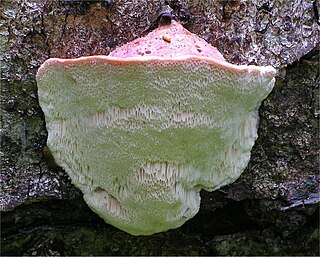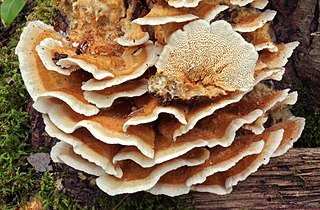
Junghuhnia is a genus of crust fungi in the family Steccherinaceae. It was circumscribed by Czech mycologist August Carl Joseph Corda in 1842. The generic name honours German-Dutch botanist Franz Wilhelm Junghuhn.

The Polyporaceae are a family of poroid fungi belonging to the Basidiomycota. The flesh of their fruit bodies varies from soft to very tough. Most members of this family have their hymenium in vertical pores on the underside of the caps, but some of them have gills or gill-like structures. Many species are brackets, but others have a definite stipe – for example, Polyporus badius.

The Fomitopsidaceae are a family of fungi in the order Polyporales. Most species are parasitic on woody plants, and tend to cause brown rots. The name comes from Fomitopsis + -aceae.

The Meruliaceae are a family of fungi in the order Polyporales. According to a 2008 estimate, the family contains 47 genera and 420 species. As of April 2018, Index Fungorum accepts 645 species in the family.

The Phanerochaetaceae are a family of mostly crust fungi in the order Polyporales.

The Steccherinaceae are a family of about 200 species of fungi in the order Polyporales. It includes crust-like, toothed, and poroid species that cause a white rot in dead wood.

Gloeoporus is a genus of crust fungi in the family Irpicaceae. The genus has a widespread distribution.

Ceriporia is a widely distributed genus of crust fungi.

Antrodiella is a genus of fungi in the family Steccherinaceae of the order Polyporales.

Irpex is a genus of corticioid fungi in the order Polyporales. Species produce fruit bodies that grow as a crust on the surface of dead hardwoods. The crust features an irpicioid spore-bearing surface, meaning it has irregular and flattened teeth. Irpex is distinguished from the similar genera Junghuhnia and Steccherinum by the simple septa found in the generative hyphae.

Loweomyces is a genus of six species of poroid fungi in the family Steccherinaceae.

Mycorrhaphium is a genus of fungi in the family Steccherinaceae. The genus was circumscribed by Dutch mycologist Rudolph Arnold Maas Geesteranus in 1962. The type species is Mycorrhaphium adustum. Fruit bodies of species in the genus have caps, stipes, and a hydnoid (tooth-like) hymenophore. There is a dimitic hyphal system, where the skeletal hyphae are found only in the tissue of the "teeth", and a lack of cystidia. The spores are smooth, hyaline (translucent), and inamyloid.

Steccherinum is a widely distributed genus of toothed crust fungi in the family Steccherinaceae.

Aurantiporus is a genus of poroid fungi in the family Meruliaceae. Circumscribed by American mycologist William Alphonso Murrill in 1905, the genus contains five species found mostly in northern temperate regions. Molecular analysis of several Aurantiporus species suggests that the genus is not monophyletic, but some other related polypore species need to be sequenced and studied before appropriate taxonomic changes can be made. In 2018, Viktor Papp and Bálint Dima proposed a new genus Odoria to contain Aurantiporus alborubescens based on multigene phylogenetic analyses. The generic name is derived from the Latin aurantius ("orange") and the Ancient Greek πόρος (pore).

Leptoporus is a genus of polypore fungi. The type species, Leptoporus mollis, is widespread throughout north temperate areas. The generic name is derived from the Ancient Greek words λεπτός ("thin") and πόρος ("pore").

Trametopsis is a fungal genus containing the single species Trametopsis cervina. Recent molecular phylogenetic analysis supports the placement of Leptoporus in the Irpicaceae.

Fibroporia is a genus of ten species of poroid crust fungi in the family Fomitopsidaceae. The genus contains species similar to those in genus Antrodia, but they are phylogenetically distinct.
Metuloidea murashkinskyi is a species of tooth fungus in the family Steccherinaceae. It is found in Europe and Asia, where it causes a white rot on the wood of deciduous trees.
Truncospora is a genus of 10 species of fungi in the family Polyporaceae.

The Irpicaceae are a family of mostly polypores and crust fungi in the order Polyporales.
















